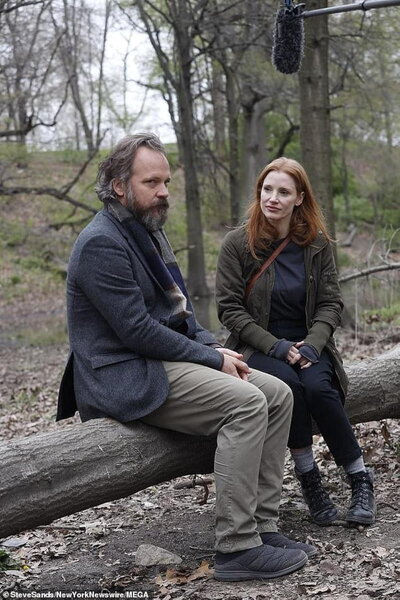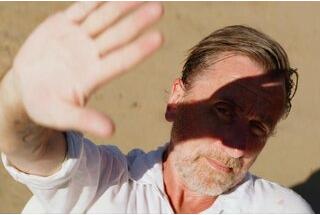Yves Cape, AFC, speaks to Seth Emmons, Leitz, about "Memory", directed by Michel Franco
Yves Cape, AFC, lets the script tell the story.Seth Emmons : Memory is your fifth film with writer/director/producer Michel Franco in less than ten years. What are the benefits or challenges of working with a director who is also the screenwriter ?
Yves Cape, AFC : It’s actually very important to the way Michel and I work. Because Michel has total freedom with the script, he can adapt in the moment. Something might work in the script but doesn’t work when you shoot it. Even if a director has worked a lot with a script, they might be afraid of changing a scene too much in case a small, important detail is lost. But Michel knows the script and the characters so well that he can confidently make those choices when a scene isn’t working. He might try to find a better way to do it or move the scene to a different place in the story, or only use part of it and move something into another scene later. He knows what is important.
Michel can twist the material, to play with it, which is interesting. Often when we start shooting, we find that perhaps the beginning or ending of a scene are not so important to the story, but it gives the actors something to start with. It feeds them a little to make the important part of the scene better and that 45 seconds scene turns into 25seconds.
Before each film, we take two weeks to read the script together. In the early films we would also do a rough shot list, but we don’t do that anymore. Now we arrive on set with a rough idea, look at the actors, and then decide what we do. For example, in the script it is written that Sylvia is looking for Saul in the park and isn’t seeing him. There we must build something. Is she running ? Is she crying ? Michel and I have ideas about this, and Michel is speaking with the actors. Sometimes they have a few ideas or say this I can do but this not. Then we decide on the shots. If I was not so familiar with the script it would not be so easy.

Michel is known for editing on set during shooting. Can you talk about how this process works ?
YC : The process is that first we will shoot a few takes of a scene. Then the DIT comes on the set and takes the card to where the editor is working close to the set, maybe another room in the house or in a truck or on the street depending on the location. He processes it and gives it directly to the editor who puts it in a timeline. The on-set editor, Oscar Figueroa, is the same editor who finishes the film as well.
We always try to do each scene in one shot. I don’t like to call it a sequence shot because they are not that long. But we try to find the best frame for the scene and do it all from there. This makes reviewing the footage easier. Also, we shoot all the scenes in chronological order, which is necessary for Michel’s process with editing on set.
What he is really doing in this process is reviewing how the characters are building as the story goes along. Did we say too much about the character ? Does the scene fit there, or should it come later ? Maybe we should discover less about the character in scene 20 and move the scene with more details to scene30. With this system we can change our minds very fast because we can quickly review how it all cuts together.

The aim is not to stop for too long, otherwise the actors want to go back to their trailers, and you lose them for a bit. But this is why we keep it very close to the set. After a quick review and Michel says it’s okay, we go up and wrap this scene and prepare for the next one.
At the end of the shooting day Michel will stay one hour or a little bit more to look through the material of that day. On Saturday he will spend half a day with the editor, then on Sunday he’ll show the edit to me and some other people, sometimes people who know nothing about the film. It’s a bit tricky when it’s the first week and you only have a general feeling about the film and the characters. Michel will have basic questions. Do you understand the character ? Do you believe that Sylvia is an alcoholic ? What is your feeling about her fear of men ? Based on those screenings he might make adjustments for the rest of the film.

Do the actors attend these review sessions ?
YC : Usually they don’t, but Jessica Chastain attended each one on Memory. Michel proposed it to her and Peter Sarsgaard in the beginning. Peter said no, but Jessica wanted to try it. Having her in the room was interesting because she never tried to have too much power over it, but really used it to grow her understanding of the character and gain a deeper feeling for the material.
That’s a fascinating way to work.
YC : It is. And it requires that all the people involved in the workflow need to be super-fast. That’s one of the reasons we shoot with RED cameras because it works very well for this.

How so ?
YC : I like the skin tones that come out of the RED cameras, so I only need to do a few in-camera setups, ISO and color temperature, to get the image quite close to what I want. I don’t use a LUT. I like the skin tones to be very natural. Even with our DIT Francisco Galván on set we don’t do too much grading. We always grade the face first, then give a little ambiance with the level of the light, but not too much touching on anything else. That’s possible because the camera, in this case the RED Monstro, gives a good definition in color and skin tones. It’s the same with the Summilux actually.
You’ve now shot eleven films using the Leitz Summilux-C lenses, four of those are films with Michel. What keeps you coming back to these lenses ?

"Everything that has to do with depth of field looks very natural to me. On skin tones, they look normal. There’s not too much definition so if we do close ups I don’t need to filter a lot. Also, I can be in front of a window that is blowing out and I don’t have a flare that is crazy. Michel, like most of the directors I work with, hates flare. And I understand because he’s doing kind of a social norm film, so as soon as you have a flare it looks a bit fake."
Sometimes with vintage lenses I feel it can look a little crazy and draw too much attention to it. I’m always trying to make my scenes look as natural as possible. I like scenes that have ambiance, but not pretty, though. In fact, I like when there is an accident, when it doesn’t look too nice.
The lenses also allow me to be very free in some ways. For example, Michel might say to me, "We need a night shot of her coming in the hallway. When can we shoot it ? When can it be night ?" I need to jump because Michel doesn’t want to shoot it two days later. He wants to shoot it that day, if possible, to see if it works in the edit. With the Summilux I can go to T1.4 and it doesn’t change anything. It’s not less contrast. I don’t have flare. We can do the shot very quickly.
What stop do you tend to shoot at ?
YC : Most of the time I’m working between T2 and T4. Outside I’ll use NDs to keep the stop, but I might go to maximum T5.6 when it’s a bit tricky like for Steadicam® or to avoid a focus problem. My main aim on set is to be with the director and to find exactly the shot we need. I like to avoid technical problems, so I try to make it very simple.

"What I really like about the Summilux-C lenses is that I can respond to any demand of the director without feeling pressure. I can be in front of a window and not worry about flare. I can go to T1.4 and it won’t be totally soft. There’s no spherical distortion with the wide lenses so I can work with any camera angle or in small spaces. I can do whatever I want."
The lenses are soft in a nice way. In combination with the RED, I know I’ll arrive at the grading with a good image. If I want to make it harder, I can add contrast. With Jessica I could be close with her and didn’t need to filter that much. I didn’t do anything special. They’re not warm and they’re not cold. They are just in the middle. They’re neutral. And I really appreciate that.
Did you use any filters on Memory ?
YC : I didn’t. And I was trying to do the opposite and destroy her natural beauty, but it was quite difficult. In the subway scene I tried to put her under the fluorescent light and even then, she looked very nice. In the end we did some cosmetic stuff, but no filters.
How do you create unique looks for various films when you use the same camera and lens combination ?
YC : Well, it is a good question. I think it’s mainly with the set decoration and the costumes and the way I’m lighting it. I’m trying to always be as honest as I can with the scene that is written. If the scene is written differently, it should look different.
A good example from Memory is when Sylvia is in bed, and she has closed the curtain. As a DP your first thought is, she should put a light on, then you have contrast. So, I put the light on, and the frame was looking fake. It didn’t feel natural. She’s depressed and when you’re depressed you don’t put the light on. You want to be under your covers and hiding yourself. I’m always trying to find the reason why, which helps me find the correct light for a scene.
Another example is when she’s sitting alone on the sofa near the end of the film with her arms wrapped around her legs. You see the sofa and you see the door that goes to the kitchen and the hallway. In the script she is depressed and basically cannot move, but she’s against the wall which is about the same color as her face. So, what do you do ?
The easiest thing again is to put on the light next to her, but it’s not in the script. Then I said to my gaffer Jay Warrior, “Maybe the hallway is on. Why don’t we try to have a light that comes from the hallway and by chance the hallway makes a backlight for her coming from there.” And that worked.
I’m always trying to work with the material, but I will also look at the actor. What do they do ? What position do they take ? Of course we have an idea of the shot, but when they sit in the bed just so, then we can find exactly the good position for the camera. And from that point I need to be quite fast to set it up.
I cannot say I need an hour or two to light the shot, so my lighting must be fast too. It’s a bit the same as the lenses and the camera. I need something that is easy to manipulate, that is not going to give me the wrong color. I’m using mostly LEDs from Arri, Aladdin and Astera but trying not to mix them and get different colours. I like to be very efficient and simple so I can also have a little time to think about it.
In some films the camera is a character and sometimes it’s an observer. How would you classify the role of the camera in Memory ?
YC : It’s important that the camera be transparent in this film. That doesn’t mean the camera is always still. In fact, we’re moving all the time. We follow them. We stop with them. But like most of Michel’s films, we are not trying to put judgment on the characters. We don’t want to say if Jessica’s character is good or bad. We don’t want to say that the mother is good or bad.
To do this, we don’t try to overplay it with the light, with the camera, with the lens, all of this. We give her a chance, let’s say. We give the story to the audience, and they must make their own opinion.
(Interview by Seth Emmons, Director of Communications at Leitz)
 En
En Fr
Fr






